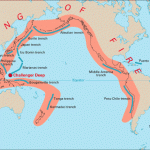The Pacific ocean is contained by a ring of fire, an inverted horseshoe shape that encompasses the long stretch coast of the Americas starting from Chile, going to Mexico, to California, Alaska then cross to East Asia, from Japan, to Philippines, Indonesia down to New Zealand.
The bow shaped ring of fire is estimated to be about 40,000 kilometers long with about 452 volcanoes equivalent to 75 percent of the Earth’s active and dormant volcanoes.
Shocks and earthquakes occurring here and there, that generated 9 out of 10 earthquakes in the world and they are caused primarily by the movement of tectonic plates that make and shape the earth’s surface.
When two sections of the Earth’s crust collide, one slab of crust can be forced back down into the deeper regions of the Earth and it usually undergoes melting when the edges get to a depth which is hot enough. (A temperature hot enough to melt lithosphere is about a thousands degrees Celsius). This process is called ‘subduction’.
Melted crust rises back towards the surface where it helps make volcanoes and islands. Thus the formation of some volcanoes, mountains, and islands is connected to the process of subduction and continental drift.
The Ring of Fire is created by the ‘subduction’ of Earth’s plate tectonics. The Earth’s crust is broken up into plates which float on top of the mantle.
When these plates come together, you can get volcanoes and earthquakes. The eastern side of the Ring of Fire has the Nazca Plate and the Cocos Plate being subducted (going underneath) the South American Plate.
And in the North, the Pacific Plate and the Juan de Fuca Plate are being subducted underneath the North American Plate. The Pacific plate is also subducting underneath the Kamchatka Peninsula and Japan.
Because of all this subduction, there are many cracks in the Earth’s crust where magma can reach the surface and erupt as volcanoes. There are volcanoes in Chile, Mexico, the United States, Canada, Russia, Japan, the Philippines, Indonesia, New Zealand and Antarctica.
